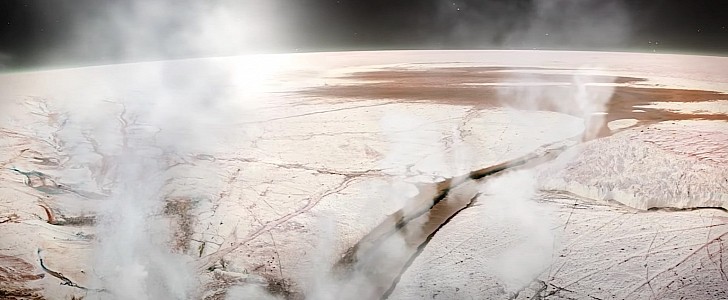The talk of the day in the world of telescopes in the James Webb. Later in December, an Ariane 5 rocket will launch the fancy hardware into orbit, opening the doors for a new age in space exploration. But the former star of the heavens, Hubble, still has something left to say, and it just screamed out loud.
Once trained on the Jovian system (that is Jupiter with its rings and moons), the telescope has been sending back images of the place for years. Scientists have been looking into them for just as long and now, as they finished with the observations spanning from 1999 to 2015, found that Hubble proved that there might be long-term water vapors on Europa.
That’s not entirely unexpected, as scientists have long believed the moon “harbors a vast ocean underneath its icy surface, which might offer conditions hospitable for life.” Even more, Hubble once confirmed 60-mile (97 km) high plumes of water vapor erupting from the surface, but until now, evidence of a constant presence of water vapor was unheard of.
What is strange though is that these long-term water vapors are to be found only on one of the moon’s hemispheres, namely on the one that is always opposite to its direction of motion along its orbit.
According to NASA, although this phenomenon is “mysterious,” it should help pave the way to a better understanding of the formation and evolution of Jupiter and its moons. Such a discovery also only fuels the scientists’ desire to send exploration missions there, and there are already two of them in the works: NASA's Europa Clipper and ESA’s Jupiter Icy Moons Explorer.
As for Europa, the place may look inhospitable – the temperature on the surface is minus 260 degrees Fahrenheit (minus 162 degrees Celsius) – but it does have a lot of things going for the existence of life in one form or another.
The moon is one of many to orbit the massive gas giant (there are close to 80 that we know of), and one of three to be almost confirmed as having oceans of water under a sheet of ice, alongside Ganymede and Callisto.
That’s not entirely unexpected, as scientists have long believed the moon “harbors a vast ocean underneath its icy surface, which might offer conditions hospitable for life.” Even more, Hubble once confirmed 60-mile (97 km) high plumes of water vapor erupting from the surface, but until now, evidence of a constant presence of water vapor was unheard of.
What is strange though is that these long-term water vapors are to be found only on one of the moon’s hemispheres, namely on the one that is always opposite to its direction of motion along its orbit.
According to NASA, although this phenomenon is “mysterious,” it should help pave the way to a better understanding of the formation and evolution of Jupiter and its moons. Such a discovery also only fuels the scientists’ desire to send exploration missions there, and there are already two of them in the works: NASA's Europa Clipper and ESA’s Jupiter Icy Moons Explorer.
As for Europa, the place may look inhospitable – the temperature on the surface is minus 260 degrees Fahrenheit (minus 162 degrees Celsius) – but it does have a lot of things going for the existence of life in one form or another.
The moon is one of many to orbit the massive gas giant (there are close to 80 that we know of), and one of three to be almost confirmed as having oceans of water under a sheet of ice, alongside Ganymede and Callisto.







